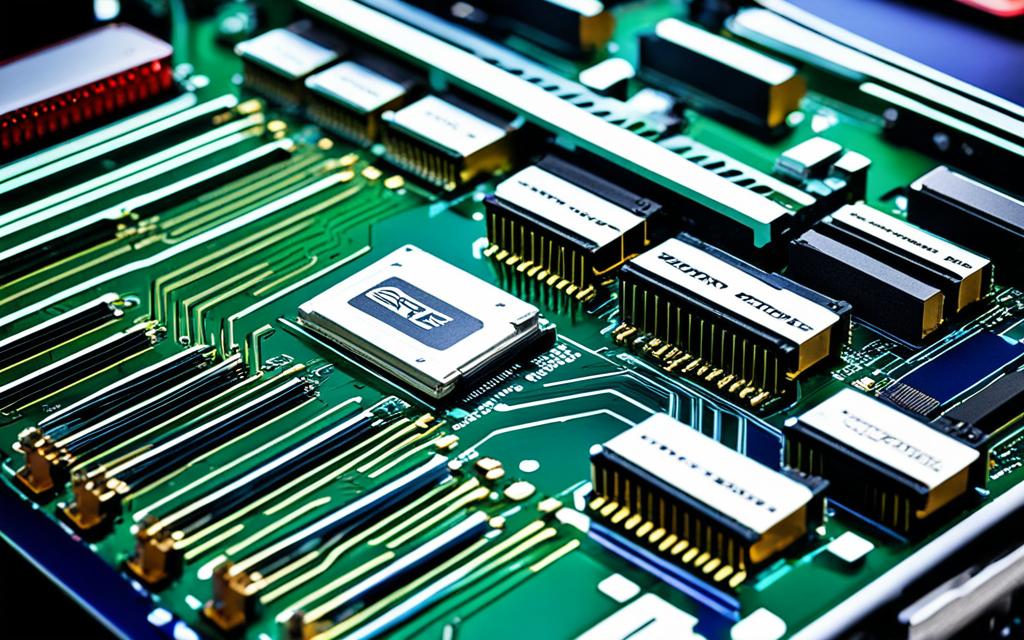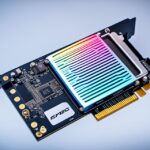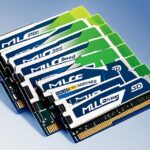Table of Contents
The amount of SSD slots on a motherboard deeply affects a computer’s performance and storage capacities. Knowing about SSD connectivity is key for anyone planning to upgrade or build a new PC. With M.2 SSDs setting new speed records—reaching up to 7200 MB/s with PCIe Gen 4 and even hitting over 10000 MB/s with PCIe Gen 5—it’s important to check if your motherboard has enough M.2 slots12.
Generally, recent motherboards have 2 to 3 M.2 slots. But, top-tier models offer up to 5 for demanding activities like gaming and heavy video editing3. Knowing about different motherboards and their slot availability helps maximize computer performance.
Key Takeaways
- The number of SSD slots directly impacts performance capabilities.
- Modern designs typically support 2 to 3 M.2 slots with premium boards offering more.
- M.2 SSDs outperform SATA SSDs considerably in speed.
- Compatible slots vary by motherboard type, influencing upgrade options.
- Understanding the differences in slot types is vital for optimal setup.
Understanding SSDs and Their Importance
Solid State Drives (SSDs) are a big step forward in storing data. They use NAND flash memory, which means faster read and write speeds than Hard Disk Drives (HDDs). Since SSDs don’t have moving parts, they are more durable and reliable. Thus, they’re great for keeping important data safe. Choosing the right storage, like SSDs, is vital for your computer’s needs. Check out this article for more on the shift to SSDs.
What are SSDs?
SSDs store data using flash memory, which lets you access your files quickly and efficiently. They’re changing how computers work by making them start up and open programs much faster. This speed boosts the overall experience of using a computer.
Advantages of Using SSDs Over HDDs
SSDs offer many benefits over HDDs. They’re tougher and better at keeping data safe, which is important for people who want to protect their work4. SSDs are also much faster thanks to a technology called NVMe. This technology uses PCIe sockets to move data up to 25 times quicker than older tech5. Plus, SSDs use less power and are cooler, which is better for the environment and small computers.
Why Upgrade to SSDs?
Switching to SSDs can improve your computer’s performance significantly. They allow you to do more at once without using too much energy4. Modern PCs often have slots for more than one SSD. This means you can increase how much you can store, from 120GB up to 2TB or more, depending on what you need6. A better storage solution means your computer will run smoother and faster.
Types of SSDs Available
Knowing the different types of SSDs can greatly improve how your device works. Each SSD type comes with its own set of strong points. They are designed for various needs. This discussion covers three key types: SATA SSDs, M.2 SSDs, and PCIe SSDs.
SATA SSDs
SATA SSDs offer a good mix of performance and cost. They can transfer data up to 6Gbps, which is enough for daily use. But, they might be slow for tasks that need more power. Even though they’re affordable and fit many devices, SATA SSDs can’t use the speedy PCIe interface like M.2 models can. This might slow them down during heavy use78.
M.2 SSDs
M.2 SSDs are small and efficient. They look like gum sticks. They come in different sizes and work with several protocols, including SATA and NVMe. M.2 SATA SSDs go as fast as the usual SATA ones. But, M.2 NVMe ones are much faster, with speeds over 5000 MB/s. This speed makes them a top choice for gamers and pros who need to process data quickly798.
PCIe SSDs
PCIe SSDs are at the top with unmatched performance. For instance, PCIe 4.0 NVMe M.2 SSDs reach read and write speeds up to 7,000MB/s. This is a huge jump from SATA SSDs’ 600MB/s. They’re great for video editing and other heavy tasks798. They’re used in everything from gaming consoles to big servers. This is because they handle a lot of data very well.
What Is an M.2 Slot on the Motherboard?
M.2 slots are a big step forward for SSD interfaces, offering a small-sized solution for better data speed. These slots are tinier than old SATA connections, showing off amazing M.2 specifications. They fit various sizes, like 2280, 2260, and 2240. Their smart design lets makers boost the performance of solid-state drives by fitting them straight onto the motherboard. This also makes more room for other parts.
Physical Characteristics of M.2 Slots
The design of M.2 slots is neat, making it easy to fit them into modern motherboards. They have a small shape, which lets makers add more storage options without losing space. It’s important to check the max length and type of M.2 SSDs your motherboard can take. This ensures they will work well together, given the growing variety in SSD styles.
Performance Differences Between M.2 and SATA Connections
Talking about M.2 vs SATA performance, it’s key to see the huge speed and efficiency gaps. While SATA SSDs can go up to 600 MB/s, M.2 NVMe SSDs can hit speeds around 3500 MB/s with PCIe Gen 3. Looking forward, Gen 5 M.2 SSDs might even pass the 10,000 MB/s mark. This clearly shows they’re much better than traditional SATA tech which tops at 600 MB/s and can’t match the speedy multichannel function needed for top performance2.
Also, M.2 NVMe SSDs need four PCIe lanes to work well, which is key to their fast performance compared to SATA SSDs2. When checking out M.2 slots, it’s clear they’re the best choice for those who need quick access for their operating systems and games. In a recent discussion, people suggested picking NVMe drives with heatsinks for the best speed. They especially talked about the difference between slots connected straight to the CPU and those linked to motherboard chipsets10.
How many SSD slots does a motherboard have
The quest to know how many SSD slots a motherboard has is shaped by a few things. The motherboard chipset mainly decides the features, including M.2 socket numbers. High-end boards often have more motherboard storage capacity with extra slots for better performance.
Factors Influencing the Number of Slots
The SSD slot count on motherboards changes a lot. EATX motherboards, for example, can have 5 to 6 M.2 slots, giving lots of choices for those wanting fast storage1. ATX motherboards might have 2 to 5 M.2 slots2. But, smaller boards like Micro ATX usually have just 1 to 3 M.2 slots. They need expansion cards for more connections1.
Typical Slot Availability on Various Motherboard Types
Most modern motherboards have about 2 to 3 M.2 SSD slots. The more advanced models, loved by enthusiasts, have 4 to 5 M.2 SSD slots2 and11. Even small boards like Mini ITX offer 2 to 3 M.2 slots. This makes them flexible despite their limited space1. You can add more slots with PCIe expansion cards, enhancing your storage without changing the motherboard directly2.
Motherboard Form Factor and Its Impact on SSD Slots
The size of the motherboard is key to how many SSD slots it has. Smaller or bigger motherboards offer different possibilities for SSD connectors. This affects how many storage options users have.
EATX Motherboards
EATX motherboards are bigger than ATX ones, with more slots for components like graphics cards and SSDs. They allow for more SSD slots, boosting the system’s storage. People who need a lot of storage pick EATX motherboards for their growth capacity1213.
ATX Motherboards
ATX motherboards are the go-to size for desktop PCs. They offer a good mix of size and function, having several SSD slots. They also support good airflow and smart placement of components. You can often find features like dual-slot for SSDs, making them great for powerful systems13.
Micro ATX and Mini ITX Motherboards
Micro ATX and Mini ITX boards are for those who want something smaller. Micro ATX is smaller but still fits standard parts, though with fewer SSD slots than ATX. Mini ITX boards are super compact, perfect for tiny builds where saving space matters13. These forms show how size and the ability to expand need to be balanced.
Enhancing Your System with Multiple SSDs
Adding several SSDs to your computer improves speed and efficiency in a big way. It helps you get the most from your storage. By knowing the advantages and performance details, you can make great use of these upgrades.
Benefits of Multiple SSDs
Using many SSDs boosts your system’s speed and lets you do more at once. Your computer can handle loads of apps without slowing down. SSDs are also tougher than old HDDs, keeping your data safer from damage. Plus, big SSDs with more SLC cache handle data better. They keep up performance even under heavy use14. Discover more benefits of having multiple SSDs.
Performance Considerations in SSD Configurations
Choosing the right setup for several SSDs is crucial. SSDs with NVMe tech reach top speeds, far outdoing traditional SATA15. What’s more, modern motherboards offer lots of M.2 slots. This means you can add more storage easily4. With more SSDs, your computer can also stay cooler. They don’t need extra power or make much heat, perfect for powerful PCs.
Conclusion
Knowing about SSD slots on a motherboard is key for boosting your computer’s storage. With SSD technology moving fast, picking the right SSD upgrade options and the right motherboard setup can really step up your computer’s speed and reliability. No matter if you’re a gamer, a content creator, or just use your computer daily, understanding how to use SSD slots lets you build a computer that meets your needs perfectly.
Using several SSDs brings huge benefits, like faster loading times and quicker responses from your system. With more types of SSDs available now, such as SATA and M.2 NVMe, you have the chance to boost performance for all kinds of tasks. As technology gets better, knowing your motherboard well prepares you for using new storage solutions that fit future upgrades.
To wrap it up, making the most of your motherboard’s SSD slots lets you excel in both performance and functionality. Spending time to learn about storage choices can dramatically improve how well your system runs, making your tech experience much more engaging. So, getting to grips with motherboard setups and SSD varieties is crucial for anyone wanting to make the most of their computer’s abilities16.
FAQ
How many SSD slots does a typical motherboard have?
The number of SSD slots on a motherboard varies. It depends on the motherboard’s chipset and its size. High-end ones tend to have more slots. They meet modern storage and performance needs.
What types of SSDs can I use with my motherboard?
You can use different types of Solid State Drives with your motherboard. These include SATA SSDs, M.2 SSDs, and PCIe SSDs. Each type has unique benefits and performance features. Choosing the right one matters for your needs.
Why is it important to know the number of SSD slots on my motherboard?
Knowing how many SSD slots your motherboard has is key for upgrades. This info lets you boost your computer’s storage. This way, it can run demanding programs and modern games well.
What advantages do M.2 SSDs offer compared to SATA SSDs?
M.2 SSDs offer much faster data speeds and are smaller than SATA SSDs. They’re great for high-speed computing and fitting into tight spaces.
How does the motherboard form factor affect SSD slot availability?
Larger motherboards, like EATX, usually have more SSD slots. This is because they have more space for extra connectors. However, smaller ones might have fewer slots due to limited room.
Can using multiple SSDs improve system performance?
Yes, using several SSDs can boost your computer’s performance. It helps with multitasking and speeds up accessing data. This means your system can run several apps smoothly at once.
What do I need to consider when upgrading to SSDs?
When looking to upgrade to SSDs, think about the slots available and the SSDs that fit your motherboard. Also, consider how much storage you’ll need, whether for gaming, video editing, or everyday tasks.
Are SSDs more reliable than traditional hard drives?
Yes, SSDs are often more reliable than HDDs. They don’t have moving parts, which makes them less prone to physical shock. This ensures your data stays safe for longer.
Source Links
- https://www.electronicshub.org/how-many-m-2-slots-on-motherboard/ – How Many M.2 Slots are On a Motherboard?
- https://www.sabrepc.com/blog/Computer-Hardware/how-to-add-m-2-nvme-ssd-to-your-motherboard – How to Add M.2 NVMe SSDs to your Motherboard
- https://www.cgdirector.com/how-many-ssd-can-you-have/ – How Many SSDs Can You Have?
- https://www.weny.com/story/50492687/what-is-the-best-way-to-know-how-many-ssd-slots-i-have – What is the best way to know how many SSD slots I have?
- https://www.kingston.com/en/ssd/what-is-nvme-ssd-technology – What is NVMe SSD technology? – Kingston Technology
- https://www.tomshardware.com/reviews/ssd-buying-guide,5602.html – How to Buy the Right SSD: A Guide for 2024
- https://www.kingston.com/en/blog/pc-performance/two-types-m2-vs-ssd – 2 Types of M.2 SSDs: SATA and NVMe- Kingston Technology
- https://www.kingston.com/en/blog/pc-performance/ssd-form-factors – Types of SSD Form Factors- Kingston Technology
- https://www.crucial.com/articles/about-ssd/m2-with-pcie-or-sata – NVMe vs M.2 vs SATA vs PCIe: What are these SSDs?
- https://www.overclock.net/threads/which-m2-slot-to-use.1809286/ – Which m2 slot to use
- https://www.gigabyte.com/Motherboard/B650-AORUS-ELITE-AX-rev-10-11 – B650 AORUS ELITE AX (rev. 1.0/1.1) Key Features | Motherboard – GIGABYTE Global
- https://www.crucial.in/articles/about-ssd/ssd-form-factors – SSD Form Factors
- https://www.knownhost.com/blog/what-is-a-form-factor/ – What is a Form Factor? – KnownHost
- https://forums.tomshardware.com/threads/using-multiple-m-2-2280-ssds-on-mobo-with-1-slot-how-to-know-if-i-can-use-expansion-slot-for-more.3016161/ – Using multiple M.2-2280 SSDs on mobo with 1 slot? How to know if I can use expansion slot for more?
- https://techfocuspro.com/how-many-ssds-can-a-pc-have/ – How many SSDs can a PC Have? – Tech Focus Pro
- https://community.acer.com/en/discussion/699468/how-many-storage-slots-for-ssds-does-my-acer-nitro-v15-anv15-51-have – How many storage slots for SSDs does my Acer nitro v15 ANV15-51 have?








